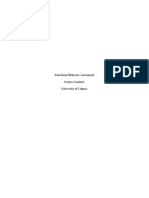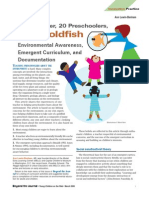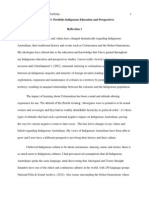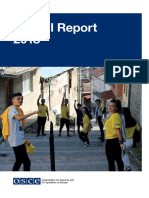Snell Kristya3
Snell Kristya3
Uploaded by
api-248878022Copyright:
Available Formats
Snell Kristya3
Snell Kristya3
Uploaded by
api-248878022Original Title
Copyright
Available Formats
Share this document
Did you find this document useful?
Is this content inappropriate?
Copyright:
Available Formats
Snell Kristya3
Snell Kristya3
Uploaded by
api-248878022Copyright:
Available Formats
Running head: Kristy Snell EDU20004.
ASS3: Case Study Case Study 1 Ashley is a four year old child who attends a kindergarten/preschool where you are the teacher. Her family has communicated to you that she enjoys physical activities and ball games, but can become upset if she is losing or having to wait for a turn. Ashley has had several outbursts since she began attending three months ago. On four separate occasions she has physically struck out at other children in the group by punching and kicking them. These incidents have been observed and documented.
Ashley is a four year old child and has been attending preschool for the last three months; young children begin to understand feelings, behaviour of others and ideas regarding the development of their temperament and personality (Doherty and Hughes, 2009). This is evident when children use their behaviour to achieve a desired outcome such as having their turn, or wanting to win majority of the time. Piaget (as cited in Doherty and Hughes, 2009), stresses the importance of moral reasoning, an ability to think through answers to questions. In Ashleys case as a four year old she needs to acquire reasoning ability and capacity to consider other childrens feelings and perspectives. When Ashley physically strikes out at a child because she is losing or wants another turn, she is not taking into consideration how the other children around her feel. The approach that teachers would employ for Ashleys behaviour would depend on the developmental stage that she is at. Ashleys behaviour could be a result of her home situation, if she has to compete for attention from her parents or siblings. Ashleys family situation could possibly be negatively impacting on her behaviour. Cultural and community contexts also play a role in behaviour expectations and development; some people accept behaviours that can be seen to others as disrespectful and unacceptable, depending on their personal values and beliefs.
Running head: Kristy Snell EDU20004. ASS3: Case Study Parents serve as powerful models of influence for children's moral development (Doherty & Hughes, 2009). Healthy self-esteem, feeling valued and contributing positively to society through effective communication and development of self-perception and perception of others significantly impacts on behaviour (Underdown, 2007). Ashleys behaviour and physical outbursts have continued for three months, it has been observed and documented on several occasions. Bronfenbrenners Ecological Model recognizes that the contexts within the environment are constantly changing and influence and are influenced by the child. There are contributing factors such as the environment, connections to family contexts, cultural influences all occurring within a time frame; these factors all contribute and influence Ashleys behaviour. The early years of childhood and development are optimal times for guiding and managing behaviour through support from teachers and other caregivers. A guidance approach flows from respectful attitudes to children, trusting that children have a need and desire to grow and learn, and to please adults around them (Porter, 2011). Ashley capacity to understand and respond to a guidance approach can be measured by implementing and observing the activating agent/cause of the behaviour, beliefs, consequences after the behaviour, an ensuring a positive outlook on the situation. Recognizing the cause of Ashleys behaviour (losing) and the consequences (Ashley physically striking out at other children- punching and kicking), involves
recognition of working towards an approach of a positive outcome by implementing strategies to turn Ashleys negative behaviour into positive behaviour. There may be influences at home that impact on Ashleys behaviour when things arent going her way, for example, losing. If Ashley feels the need to win all of the time, the family influences around her may be pressuring her to always win, therefore Ashley does not recognize and comprehend that other children also have the right to have a turn and succeed. Ashley enjoys
Running head: Kristy Snell EDU20004. ASS3: Case Study
physical activities and ball games, these can generally involve outdoor spaces. Providing Ashley with other experiences relating to her interest can also be done through a more manageable and controlled environment. This can be done by taking into consideration the size of the class, ensuring that there are enough activities for all of the children to experience. Role modelling appropriate behaviour and language throughout these experiences helps to emphasize that all children have feelings, needs and want to succeed; implementing these factors into experiences can enable positive interactions and behaviours. Ashleys situation at home could be that she is struggling to get what she wants from her parents and is resorting to physical behaviour to achieve her desired goal. Ashleys parents are aware of her behaviour as they have communicated it to the teacher, only outlining the negative behaviour; the consequences have not been mentioned. Ashley may be allowed to get away with this behaviour at home, therefore the physical behaviour that is being displayed is somewhat accepted, as she is continuing to display this behaviour at preschool. As Ashleys behaviour has been observed and documented on several occasions, there is an evident need of a strategy to be put in place to achieve a positive outcome for Ashley. Ashley is indicating through her physical outbursts that she feels the need to win and that it should be her turn at an activity. Ashley might not have the language and communication skills to be able to effectively portray her feelings; instead resorting to physical behaviour towards other children. Behaviour can be seen as a reaction or response to a particular situation and also a form of communication. Nurturing relationships and providing Ashley with consistent support can assist in the development of skills and understandings that are required to interact positively with others (Mathieson & Raban, 2012). All actions have consequential outcomes that impact directly
Running head: Kristy Snell EDU20004. ASS3: Case Study on Ashley and those around her. Ashleys physical behaviour is not acceptable when she is
hurting children around her; this promotes negative behaviour and can impact on childrens selfesteem and self-concept. Different students are motivated in different ways and the learning environment needs to reflect this. A Functional Behaviour Assessment (FBA) is a problem solving process for addressing student problem behaviour; it aims to identify the behaviour and to assist teachers to develop interventions to address the behaviour (Conway, 2009). The focus needs to be placed on identifying social, emotional, cognitive and environmental factors that are possibly contributing to the occurrence of Ashleys behaviour. There are six important factors that need to be taken into consideration: Ashleys age, the setting, intensity of the behaviour, the duration of the behaviour, the frequency and home and cultural factors (Conway, 2009). Guiding Ashley to understand that her behaviour is hurting other children by explaining through conversations, for example, how do you think it might make him feel if you punch or kick him?, when you are feeling frustrated you can use your words instead of your body, taking turns lets everybody have a turn, well done, you did a great job throwing the ball, lets see if he can throw the ball too. Providing these conversations enables mutual respect, trust and support to give children the confidence that is needed to play, take risks and persevere (Whitebread & Coltman, 2008). The teacher can support this by negotiating and setting clear behaviour boundaries within the classroom of what is acceptable and what will not be tolerated. Building a positive classroom environment, requires teachers to embrace diversity and to create opportunities for reciprocity in learning; sharing decision making, problem solving, ownership and responsibility strengthens a positive classroom environment (Carrington & MacArthur, 2012). Encouraging positive choices for Ashley and support for difficult situations
Running head: Kristy Snell EDU20004. ASS3: Case Study will enable Ashley to improve her behaviour in a positive way. Developing a behaviour plan for Ashley will assist the teacher in managing the behaviour with support of the school network and outside support agencies (if required). The plan attempts to identify the particular need or desire the child is attempting to achieve/communicate by the disruptive behaviour (Cameron & Maginn, 2009). This plan involves interventions involving specific actions that target Ashleys
behaviour. Addressing the antecedent for the behaviour and to offer effective solutions requires a structured set of actions to be implemented within a relevant time frame and is constantly reviewed to evaluate the effectiveness/ineffectiveness of the strategies. Teachers, parents and school support workers are required to be involved in the development of a behaviour support plan, this is to identify behaviours of concern, desired outcome, agreed management strategies, who is to implement the strategies and monitoring the strategies. Emergent curriculum can also be beneficial to supporting behaviour management plans as a curriculum develops from what is relevant, interesting and personally meaningful to children (Queensland Study Authority, 2013). Emergent curriculum is a constantly changing response to childrens changing needs and interests, parental and community interests and concerns, and teacher priorities; providing opportunities for exciting, challenging and motivated learning through authentic assessment practices and contexts for learning (Queensland Study Authority, 2013). This emergent curriculum enables parents to communicate and contribute to their childrens learning within a child responsive program. The physical environment is also an important factor and contributor to behaviour. Providing an environment that is lacking in creativity, unsuitable experiences, and negative behaviour modelling and aesthetics sets children up for failure and provides opportunities for negative behaviours to occur. Environments need to offer multiple choices to children, various
Running head: Kristy Snell EDU20004. ASS3: Case Study activities, promotion of positive behaviour through behaviour modeling and guidance strategies. This invites children to learn and accept what they can do, how to achieve their goals through collaborative partnerships with each other. Challenging behaviours such as Ashleys can be
managed by implementing appropriate practices, philosophies and curriculum that are beneficial to the children and teachers within the preschool. Strategies that can be used to coincide with the physical environment to support Ashleys behaviour involve sensitivity, consistency, trust, collaborative relationships, receptiveness and understanding. This can be done by providing interactions that are of a positive nature, communicating efficiently and effectively, finding constructive outcomes and strategies to resolve frustrations (such as kicking and punching), and promoting equality and co-operation through appropriate role modelling of behaviour. For children to learn in a formal school environment, they must be able to regulate their own behaviours and emotions, communicating and engaging with others in socially appropriate ways (Fisher, 2011). Encouraging Ashley to use language instead of physical actions when communicating a need can be achieved through consistent and clear interventions when Ashley is becoming frustrated. Attempts to intervene before the outbursts occur, through redirection of Ashleys attention to a different activity. Redirecting children away from conflict, provides opportunity for learning how to deal with negative situations and reducing the need for negative situations that may damage their selfesteem of themselves and others around them (Kearns, 2010). Promoting awareness of how actions can impact on others in regards to feelings and emotions enable children to recognize and accept the ethical dimensions within society that they are a part of. Challenges that can be experienced in regards to strategies and behaviour support plans include ethical, familial and cultural considerations. What a teacher may define as appropriate
Running head: Kristy Snell EDU20004. ASS3: Case Study
response to behaviour may differ immensely from a parental opinion. Ashleys parents are aware of the behaviour that is occurring but might not be able to control it because they do not have the tools and resources available to them. Through communication and strategizing an effective outcome can be achieved for Ashley by providing support and constant communication to her parents. Cultural diversity poses challenges to learning environments as different cultures accept different types of behaviours. Children need to know that expression of their culture is allowed, but at the same time they need to be aware of the rules within the class (Wolfgang, 2009). This can be achieved and promoted through clear and consistent boundaries, rules and limits that the teacher, children and families contribute to through discussion and decision making. Preparing a suitable environment for Ashley is important to guide her behaviour to become more positive. Strategies and behaviour management plans are an effective way of contributing to the development of positive and acceptable behaviour. Various types of behaviours are displayed by children as they grow, develop and explore the world around them. Supporting children to develop an understanding of acceptable behaviour through role modeling and behaviour support plans enables clear outcomes to be defined and achieved. Effective communication is fundamental to include families in the behaviour management process to develop a pathway leading to the undesirable behaviour to subside. Teachers offer support and guidance in regards to behaviour, to both students and families with the intent to achieve maximum learning and development throughout the educational years.
Running head: Kristy Snell EDU20004. ASS3: Case Study References Cameron, R., & Maginn, C. (2009). Achieving positive outcomes for children in care. London, UK: Sage. Carrington, S. B., & MacArthur, J. (2012). Teaching in Inclusive School Communities. Milton, Qld: John Wiley & Sons Australia, Ltd. Conway, R. (2009). Teaching-Learning Environments.
In Ashman, A. F., & Elkins, J. (Eds). Educating for inclusion and diversity (pp 130-142). Frenchs Forest, NSW: Pearson Education Australia. Doherty, J., & Hughes, M. (2009). Child development. England: Longman / Pearson. Fisher (2011) as cited in: Goldstein, J. (2012). Play in Childrens Development, Health and Wellbeing. Retrieved February 8, 2014 from: http://www.ornes.nl/wpcontent/uploads/2010/08/Play-in-children-s-development-health-and-well-being-feb2012.pdf Kearns, K. (2010). Frameworks for learning and development. (2nd Ed.). French Forest, NSW: Pearson pp. 133-141 Mathieson, K., & Raban, B. (2012). Understanding Behaviout in the Early Years. A practical guide to supporting each childs behaviour in the early years setting.
Running head: Kristy Snell EDU20004. ASS3: Case Study Albert Park: Teaching Solutions. Porter, L. (2011). A Guidance Approach to Discipline: Theoretical Foundations. Milton, QLD: Small Poppies International. Queensland Study Authority. (2013). Understanding emergent curriculum in practice. Retrieved from: http://www.qsa.qld.edu.au/downloads/p_10/qklg_pd_mod3_exa1_emerg_curric.pdf Underdown, A. (2011). Young childrens health and well-being. Berkshire. England: Open University Press. Whitebread, D., & Coltman, P. (2008). Teaching and learning in the early years. Oxon, UK: Routledge. Wolfgang, C. H. (2009). Solving discipline and classroom management problems. Methods and models for today's teachers (7th Ed.). USA: Wiley.
You might also like
- Edu20002 Assignment Two Rumeysa OngelDocument8 pagesEdu20002 Assignment Two Rumeysa OngelrumeysaNo ratings yet
- Wills Trusts and Estate Administration 8th Edition Hower Test BankDocument4 pagesWills Trusts and Estate Administration 8th Edition Hower Test Bankxomemife0% (1)
- Plan A Play ExperienceDocument7 pagesPlan A Play ExperienceFarahNo ratings yet
- Child Observation Form For NovemberDocument4 pagesChild Observation Form For Novemberapi-397169334No ratings yet
- Edu20002 Assignment 3 - Folio Rumeysa OngelDocument10 pagesEdu20002 Assignment 3 - Folio Rumeysa OngelrumeysaNo ratings yet
- State V Denver Fenton AllenDocument20 pagesState V Denver Fenton AllenPat RileyNo ratings yet
- EDU20002: Assignment 3 Template: Student Name: Rumeysa Ongel Student ID: 103011788Document8 pagesEDU20002: Assignment 3 Template: Student Name: Rumeysa Ongel Student ID: 103011788rumeysaNo ratings yet
- Leveraging Advances in The Biology of Adversity & Resilience To Reduce Inequalities in Life OutcomesDocument8 pagesLeveraging Advances in The Biology of Adversity & Resilience To Reduce Inequalities in Life OutcomesNational Press Foundation100% (1)
- Abraham Maslow enDocument19 pagesAbraham Maslow enMenesteroso DesgraciadoNo ratings yet
- Edu 144 Portfolio Case Study ObservationsDocument10 pagesEdu 144 Portfolio Case Study Observationsapi-249260151No ratings yet
- Deca Parent Letter - EnglishDocument1 pageDeca Parent Letter - Englishapi-372771416No ratings yet
- Family Engagement Plan PaperDocument6 pagesFamily Engagement Plan Paperapi-354741670No ratings yet
- Child DevelopmentDocument9 pagesChild Developmentapi-356027426No ratings yet
- Ifsp Ei Worddoc 1Document13 pagesIfsp Ei Worddoc 1api-538947968No ratings yet
- Youlia Weber - Trauma 101 For Educators - Eduu 602Document6 pagesYoulia Weber - Trauma 101 For Educators - Eduu 602api-542152634No ratings yet
- Autism Spectrum Disorder Part 1Document4 pagesAutism Spectrum Disorder Part 1jenny lou novidaNo ratings yet
- Snell Kristya1Document6 pagesSnell Kristya1api-248878022No ratings yet
- EDU20002: Assignment 3 Template: Student Name: Rumeysa Ongel Student ID: 103011788Document10 pagesEDU20002: Assignment 3 Template: Student Name: Rumeysa Ongel Student ID: 103011788rumeysaNo ratings yet
- EDU20002 Maths in PracticeDocument8 pagesEDU20002 Maths in PracticeMarnie JanineNo ratings yet
- Child StudyDocument29 pagesChild Studyapi-501003650No ratings yet
- Fba Luke Spencer-1Document29 pagesFba Luke Spencer-1api-159547603No ratings yet
- Edu20002 Final Document Assessment 3 Folio Fiona Pidgeon 657999xDocument25 pagesEdu20002 Final Document Assessment 3 Folio Fiona Pidgeon 657999xapi-248449212100% (7)
- Child CareDocument10 pagesChild CareezmoulicNo ratings yet
- Why Teach Higher Higher Order Thinking SkillsDocument4 pagesWhy Teach Higher Higher Order Thinking SkillschandrikaNo ratings yet
- Observational LearningDocument6 pagesObservational LearningAnna Vinessa CaoleNo ratings yet
- ESCAPE BEHAVIOR McComas Et Al. 2000Document15 pagesESCAPE BEHAVIOR McComas Et Al. 2000MariaNo ratings yet
- Gartrell 01Document7 pagesGartrell 01Aimée Marie Colomy0% (1)
- Social and Emotional IntelligenceDocument4 pagesSocial and Emotional Intelligenceapi-524668763No ratings yet
- King Focused Preschool ObservationDocument14 pagesKing Focused Preschool Observationapi-348470934100% (1)
- Observational LearningDocument20 pagesObservational LearningAlexandra AddaNo ratings yet
- Concept and Principle of Child DevelopmentDocument16 pagesConcept and Principle of Child Developmentmomu100% (1)
- Do Learning Stories Tell The Whole Story of Children S Learning A Phenomenographic EnquiryDocument14 pagesDo Learning Stories Tell The Whole Story of Children S Learning A Phenomenographic EnquirycatharinaNo ratings yet
- Guidance for Supporting Gender Diversity in Early Childhood EducationFrom EverandGuidance for Supporting Gender Diversity in Early Childhood EducationNo ratings yet
- The Importance of Early Childhood DevelopmentDocument4 pagesThe Importance of Early Childhood DevelopmentJESS M. ARCEO100% (1)
- Child PortfolioDocument4 pagesChild Portfolioapi-283943637100% (1)
- One TeacherDocument7 pagesOne Teacherapi-235065651100% (1)
- Infant ObservationDocument3 pagesInfant Observationapi-250221561No ratings yet
- Supporting Children's Well Being in Montessori SettingsDocument2 pagesSupporting Children's Well Being in Montessori SettingsBenoit-Vincent Beainy100% (1)
- Preschool Parent Handbook 09-10Document20 pagesPreschool Parent Handbook 09-10Mawan ManyokNo ratings yet
- The Importance of Care Routines in Early Childhood SettingsDocument3 pagesThe Importance of Care Routines in Early Childhood Settingsapi-307622028100% (2)
- Assignment 2 Child CareDocument11 pagesAssignment 2 Child CarecocoaugNo ratings yet
- Day 9 - Field Practicum 3 Responsive Planning TemplateDocument2 pagesDay 9 - Field Practicum 3 Responsive Planning Templateapi-239582310No ratings yet
- Introduction To Early Childhood EducationDocument13 pagesIntroduction To Early Childhood EducationLittle Red100% (1)
- FamiliesDocument26 pagesFamiliesChaoukiNo ratings yet
- Early Childhood Education PhilosophyDocument3 pagesEarly Childhood Education PhilosophyHa HangNo ratings yet
- Early Childhood Lesson PlanDocument4 pagesEarly Childhood Lesson Planapi-278256418100% (1)
- B.F. Skinner Lit ReviewDocument6 pagesB.F. Skinner Lit ReviewimdebbasNo ratings yet
- Eced 303 Personal Literacy-3Document9 pagesEced 303 Personal Literacy-3api-574583866No ratings yet
- Early Childhood Classroom ObservationDocument24 pagesEarly Childhood Classroom Observationapi-339989449No ratings yet
- Carter 2007 PDFDocument6 pagesCarter 2007 PDFIdol Yo100% (1)
- Ifsp AssignmentDocument6 pagesIfsp Assignmentapi-268593344No ratings yet
- Cumulative Effect of Loneliness and Social IsolatiDocument9 pagesCumulative Effect of Loneliness and Social IsolatiLester Jay PableoNo ratings yet
- Assessment Handouts All PDFDocument31 pagesAssessment Handouts All PDFCarmeli VillavicencioNo ratings yet
- Edf3321 Assignment 2 - Qi Hui Tai - Learning Story 1 - ErinDocument2 pagesEdf3321 Assignment 2 - Qi Hui Tai - Learning Story 1 - Erinapi-239804654No ratings yet
- Child 230-Dap PaperDocument7 pagesChild 230-Dap Paperapi-512229114No ratings yet
- EDU20002 Assessment 3Document13 pagesEDU20002 Assessment 3Marnie JanineNo ratings yet
- Reem - Observations Proforma BDocument2 pagesReem - Observations Proforma Bapi-487616751No ratings yet
- Eced 303 Observation and ReflectionDocument10 pagesEced 303 Observation and Reflectionapi-574583866100% (1)
- Slade Et Al (2013) Evaluating The Impact of Forest Scholls A - A Collaboration Bet Ween A Universituy An A Primary SchollDocument7 pagesSlade Et Al (2013) Evaluating The Impact of Forest Scholls A - A Collaboration Bet Ween A Universituy An A Primary SchollAna FerreiraNo ratings yet
- Ers Narrative RevisedDocument7 pagesErs Narrative Revisedapi-596349166No ratings yet
- Sex EdDocument18 pagesSex Edjoeriz jillNo ratings yet
- Kristy Snella3Document9 pagesKristy Snella3api-248878022No ratings yet
- Snell Kristya2Document11 pagesSnell Kristya2api-248878022No ratings yet
- Kristysnella 1Document6 pagesKristysnella 1api-248878022No ratings yet
- Snell Kristya2Document13 pagesSnell Kristya2api-248878022No ratings yet
- Snell Kristya1Document2 pagesSnell Kristya1api-248878022No ratings yet
- Snell Kristya2Document12 pagesSnell Kristya2api-248878022No ratings yet
- Individual Assignment Coversheet - Psychology and Education UnitsDocument9 pagesIndividual Assignment Coversheet - Psychology and Education Unitsapi-248878022No ratings yet
- Individual Assignment Coversheet - Psychology and Education UnitsDocument10 pagesIndividual Assignment Coversheet - Psychology and Education Unitsapi-248878022No ratings yet
- The Benefits of Taking RisksDocument2 pagesThe Benefits of Taking RisksLatha MNo ratings yet
- Power of ThoughtsDocument3 pagesPower of ThoughtsSiyaram KumarNo ratings yet
- Chapter 03 - Differences in Culture - Charles W. L. Hill 9e - PPTDocument23 pagesChapter 03 - Differences in Culture - Charles W. L. Hill 9e - PPTshoaib100% (2)
- Movements of Thought in The Nineteenth Century - George Herbert Mead (1936)Document572 pagesMovements of Thought in The Nineteenth Century - George Herbert Mead (1936)WaterwindNo ratings yet
- Local Media7258853188239025076Document8 pagesLocal Media7258853188239025076Jeff ElrichNo ratings yet
- The Belbin Team RolesDocument10 pagesThe Belbin Team RolesMarlon BoucaudNo ratings yet
- AdvantageDocument10 pagesAdvantageClifMcKinleyNo ratings yet
- Diagramming Arguments Asecond Technique For The Analysis of Arguments Is DiagrammingDocument5 pagesDiagramming Arguments Asecond Technique For The Analysis of Arguments Is DiagrammingputriarumNo ratings yet
- The Demands of Society From: The Teacher As A ProfessionalDocument17 pagesThe Demands of Society From: The Teacher As A Professionale chat moNo ratings yet
- Impact of Social Networking Sites On The Youth of India 731120240Document5 pagesImpact of Social Networking Sites On The Youth of India 731120240rumarakeshNo ratings yet
- Disc Vs MbtiDocument2 pagesDisc Vs Mbtiimperiallight100% (1)
- Silicon Valley Community Foundation LetterDocument2 pagesSilicon Valley Community Foundation LetterBayAreaNewsGroupNo ratings yet
- 2010 Bar Review Notes in Political Law by Atty. Dela CruzDocument258 pages2010 Bar Review Notes in Political Law by Atty. Dela CruzilovelawschoolNo ratings yet
- Message To Garcia EssayDocument4 pagesMessage To Garcia Essayeikmujnbf100% (2)
- 15 4 The Rebirth of ReformDocument56 pages15 4 The Rebirth of Reformapi-299659784No ratings yet
- Training Design YIELDDocument3 pagesTraining Design YIELDAnonymous tlQd2LI50% (2)
- Lawoftorts Important QuestionsDocument57 pagesLawoftorts Important QuestionsNishantvermaNo ratings yet
- Garingarao V People PersonalDocument2 pagesGaringarao V People PersonalGerard LeeNo ratings yet
- Persuasive Speech in Private InstitutionDocument13 pagesPersuasive Speech in Private InstitutionKissy Grace Manila SalvadorNo ratings yet
- Entores LTD V Miles Far East Corporation - (Document10 pagesEntores LTD V Miles Far East Corporation - (Mardhiah RamlanNo ratings yet
- Fayol's Administrative ManagementDocument35 pagesFayol's Administrative ManagementAnkapa Naidu DamaNo ratings yet
- Phiadelphia Police DirectiveDocument2 pagesPhiadelphia Police DirectiveDustin SlaughterNo ratings yet
- Pharmacists and CommunicationDocument5 pagesPharmacists and CommunicationMichael BonettNo ratings yet
- Thai Code For DesignDocument5 pagesThai Code For DesignThien MaiNo ratings yet
- OSCE - Anual Report 2018Document108 pagesOSCE - Anual Report 2018K. Rafał DobrzenieckiNo ratings yet
- Dunes West Golf Club, LLC v. Town of Mount Pleasant, No. 2011-194211 (S.C. Jan. 9, 2013)Document34 pagesDunes West Golf Club, LLC v. Town of Mount Pleasant, No. 2011-194211 (S.C. Jan. 9, 2013)RHTNo ratings yet
- If God, Why Evil?Document18 pagesIf God, Why Evil?Bethany House Publishers100% (3)
- OB Exam 1 Practice QuestionsDocument2 pagesOB Exam 1 Practice QuestionsSydney EverettNo ratings yet

































































































